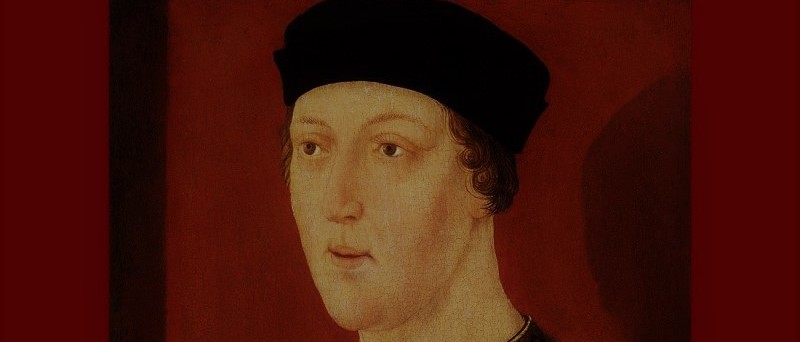Henry VI of England
Posted on 4th January 2021
Henry was born on 6 December 1421 at Windsor Castle, the only child of King Henry V and Catherine of Valois. He was only nine months old when he succeeded to the throne of England, following his father, Henry Vs death while on campaign in France. Two months later he became King of France, following the death of his maternal grandfather King Charles VI.
Reign 1422 - 1461
Until Henry was of an age to take the throne, John, Duke of Bedford, eldest brother of Henry IV became senior regent of the realm. He was placed in charge of the ongoing war in France and was based in France. Daily rule of England was placed in the care of Henry IVs younger brother Humphrey, Duke of Gloucester, named Lord Protector and Defender of the Realm.
Shortly before his eighth birthday Henry VI of England was crowned on 6 November 1429 at Westminster Abbey, then crowned King of France on 16 December 1431 at Notre Dame in Paris. Henrys rule of France would always be contested; the French had named their own, King Charles VII.
When Henry turned sixteen in 1437, he finally began to rule his kingdom.
The Hundred Years War in France continued and the tide had turned against England with France gaining many victories. Henry under the guidance of William de la Pole, Earl of Suffolk was convinced that securing peace with France was the best option and a marriage between himself and Margaret of Anjou, niece of Charles VII was agreed. Charles did not pay the customary dowry, but instead received the lands of Maine and Anjou, as named in the Treaty of Tours. The return of these lands was kept secret from parliament as Henry knew that it would be unpopular with them.
Henry and Margaret of Anjou were married on 23 April 1445 at Titchfield Abbey. They were complete opposites; Henry a deeply religious man with little interest in government, whereas Margaret a strong, formidable woman, happy to lead and make decisions and Henry was happy to be led by her.
In 1453 Henry showed signs of mental illness and Richard, Duke of York, cousin of the King was named Lord Protector. This angered Margaret as she believed she and her favourite, Edmund Beaufort, Duke of Somerset should have been placed in charge. York and Margaret would become bitter enemies.
On 13 October 1453 Margaret gave birth to a son Edward, Prince of Wales. York spread rumours that the son was not fathered by Henry, but by the Duke of Somerset.
Henry recovered from his illness in December 1454 and York was removed from power. Margaret now had power back in her hands.
Richard, Duke of York was determined to secure the throne of England and he raised an army with the assistance of Richard, Earl of Warwick and Richard, Earl of Salisbury.
The two families within the Plantagenet Dynasty, York and Lancaster would now fight each other for control. Fathers fighting sons, brothers fighting cousins and uncles fighting nephews. This would become known as the Wars of the Roses; Yorkist forces fighting against Margaret’s Lancastrian army. Margaret was determined to secure the English throne for her son.
The First Battle of St Albans took place on 22 May 1455, a resounding victory for Yorkist forces with Edmund, Duke of Somerset murdered and Margaret fleeing into exile with her son.
At the Battle of Northampton on 10 July 1460, Henry VI was captured and imprisoned. In October 1460 Henry now changed the right of succession to the throne of England to Richard, Duke of York and his heirs; York was now Lord Protector.
Henry had disinherited his own son Edward and his wife Margaret angered by this would continue to fight for the rights of her son.
At the Battle of Wakefield on 30 December 1460, Richard, Duke of York was killed. The fight would still continue through his allies and his son.
Margaret’s Lancastrian forces were victorious at the Second Battle of St Albans, where her husband Henry, suffering from a bout of madness was found sitting under a tree, singing.
Yorkist forces under the leadership of York’s son, Edward, Earl of March, marched to London and named Edward IV King of England in March 1461. England now effectively had two kings, a situation that could not continue.
Edward fell out with his allies in 1470, leading to Henry being returned to the throne on 30 October 1470, but this lasted for less than six months, with Henry being imprisoned again in the Tower of London.
Margaret fought again at the Battle of Tewkesbury on 4 May 1471, where her son Edward, Prince of Wales was executed. The death of her beloved son broke her spirit to fight anymore; she was imprisoned in the Tower of London, a shadow of her former self; later ransomed to live out her final years in France.
The death of Henrys son, sealed his own fate. He died, believed murdered in the Tower of London on 21 May 1471.
Following his death, the Wars of the Roses would continue until the Battle of Bosworth Field in 1485.
Tagged as: Junior Middle Ages
Share this post:





